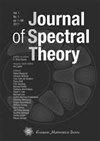关于Hilbert变换算子在多区间上的谱性质
IF 0.8
3区 数学
Q1 MATHEMATICS
引用次数: 2
摘要
设$J,E\subet\mathbb R$是两个内部不相交的多重区间。考虑以下运算符$$A:\,L^2(J)\to L^2(E),\(Af)(x)=\frac1\pi\int_{J}\frac{f(y)\text{d}y}{x-y},$$,并设$A^\digge$为其伴随。我们引入了一个作用于$L^2(E)\oplus L^2(J)$的自伴算子$\mathscr K$,它的非对角块由$a$和$a^\dagge$组成。本文研究了$\mathscr K$和算子$A^\daggeA$和$A^\Dagge$的谱性质。我们的主要工具是使用适当的Riemann-Hilbert问题获得$\mathscr K$的预解式,用$\mathSCRR$表示,然后计算$\mathscr R$在谱参数$\lamba$中的跳跃和极点。我们证明了$\mathscr K$的谱具有绝对连续分量$[0,1]$当且仅当$J$和$E$具有公共端点,并且其多重性等于它们的数目。如果没有公共端点,$\mathscr K$的谱仅由特征值和$0$组成。如果存在公共端点,则$\mathscr K$可能具有嵌入在连续谱中的特征值,每个特征值具有有限的多重性,并且特征值可能仅在$0$处累积。在所有情况下,$\mathscr K$都不具有奇异连续谱。还得到了$A^\daggeA$和$A^\Dagge$的光谱性质,它们与$\mathscrK$的光谱特性非常相似。本文章由计算机程序翻译,如有差异,请以英文原文为准。
On the spectral properties of the Hilbert transform operator on multi-intervals
Let $J,E\subset\mathbb R$ be two multi-intervals with non-intersecting interiors. Consider the following operator $$A:\, L^2( J )\to L^2(E),\ (Af)(x) = \frac 1\pi\int_{ J } \frac {f(y)\text{d} y}{x-y},$$ and let $A^\dagger$ be its adjoint. We introduce a self-adjoint operator $\mathscr K$ acting on $L^2(E)\oplus L^2(J)$, whose off-diagonal blocks consist of $A$ and $A^\dagger$. In this paper we study the spectral properties of $\mathscr K$ and the operators $A^\dagger A$ and $A A^\dagger$. Our main tool is to obtain the resolvent of $\mathscr K$, which is denoted by $\mathscr R$, using an appropriate Riemann-Hilbert problem, and then compute the jump and poles of $\mathscr R$ in the spectral parameter $\lambda$. We show that the spectrum of $\mathscr K$ has an absolutely continuous component $[0,1]$ if and only if $J$ and $E$ have common endpoints, and its multiplicity equals to their number. If there are no common endpoints, the spectrum of $\mathscr K$ consists only of eigenvalues and $0$. If there are common endpoints, then $\mathscr K$ may have eigenvalues imbedded in the continuous spectrum, each of them has a finite multiplicity, and the eigenvalues may accumulate only at $0$. In all cases, $\mathscr K$ does not have a singular continuous spectrum. The spectral properties of $A^\dagger A$ and $A A^\dagger$, which are very similar to those of $\mathscr K$, are obtained as well.
求助全文
通过发布文献求助,成功后即可免费获取论文全文。
去求助
来源期刊

Journal of Spectral Theory
MATHEMATICS, APPLIED-MATHEMATICS
CiteScore
2.00
自引率
0.00%
发文量
30
期刊介绍:
The Journal of Spectral Theory is devoted to the publication of research articles that focus on spectral theory and its many areas of application. Articles of all lengths including surveys of parts of the subject are very welcome.
The following list includes several aspects of spectral theory and also fields which feature substantial applications of (or to) spectral theory.
Schrödinger operators, scattering theory and resonances;
eigenvalues: perturbation theory, asymptotics and inequalities;
quantum graphs, graph Laplacians;
pseudo-differential operators and semi-classical analysis;
random matrix theory;
the Anderson model and other random media;
non-self-adjoint matrices and operators, including Toeplitz operators;
spectral geometry, including manifolds and automorphic forms;
linear and nonlinear differential operators, especially those arising in geometry and physics;
orthogonal polynomials;
inverse problems.
 求助内容:
求助内容: 应助结果提醒方式:
应助结果提醒方式:


